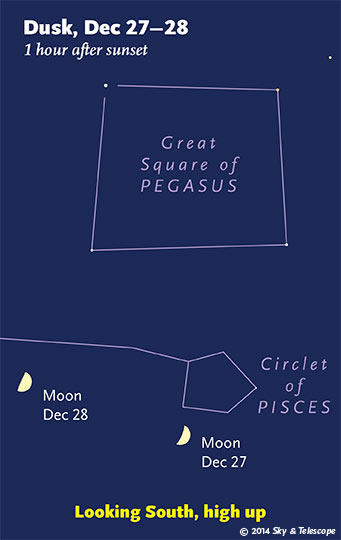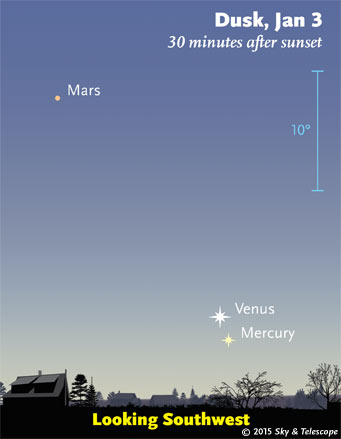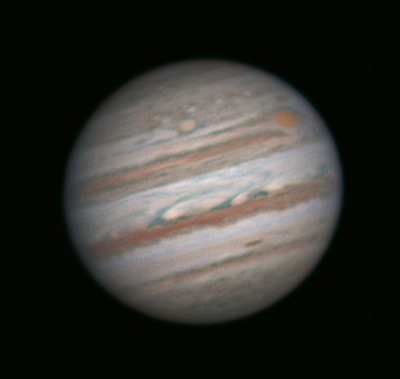Some daily sky sights among the ever-changing Moon, planets, and stars.
Friday, December 26
This is the time of year when Orion shines in the east-southeast after dinnertime. Although he's well up now, his three-star Belt is still nearly vertical. The Belt points up toward Aldebaran and, beyond Aldebaran, the Pleiades. In the other direction, the Belt points down to where bright Sirius is about to rise and twinkle furiously.
Got a first telescope for Christmas? Know someone who did? Read our advice! What to See with Your New Telescope.

Saturday, December 27
The Moon is almost first-quarter this evening. Look above it at dusk, or to its upper right after dinnertime, for the Great Square of Pegasus. At dusk the Square is upright, as shown here. Later in the evening it turns to balance on one corner.
Sunday, December 28
The first-quarter Moon (exactly first-quarter at 1:31 p.m. EST) shines in Pisces this evening, not far from 6th-magnitude Uranus. The Moon occults Uranus for Japan and parts of the Arctic.
Monday, December 29
No matter where you are, even under a dome of city light pollution, deep-sky objects await your binoculars. At least a few of them. One is the big Alpha Persei Association, now high overhead. See Gary Seronik's Binocular Highlight article and chart in the January Sky & Telescope, page 45.
Tuesday, December 30
As Gemini rises into nice evening view this season, with Castor shining over Pollux in the east, keep a telescopic watch on the red variable star R Geminorum: an unusual type-S star with a weird mix of rare elements. It's about magnitude 8.3 right now, on its way to a roughly 7th-magnitude maximum in February. See the article and finder chart in the January Sky & Telescope, page 51.
Wednesday, December 31
After the midnight cheering at the turning of 2015, step outside into the silent dark. Look south. There shines Sirius, the highest you'll see it. Upper right of it stands Orion. Upper left of Sirius is Procyon. Off your right shoulder, the gibbous Moon hangs in the west. And off your left shoulder, bright Jupiter dominates the east.
Earlier this evening, Jupiter's moon Ganymede disappears into eclipse by Jupiter's shadow at 10:18 p.m. EST. Europa follows Ganymede into Jupiter's shadow at 11:00 p.m. EST, fading away more rapidly.

Thursday, January 1
The waxing gibbous Moon shines in or near the Hyades this evening. Late tonight the Moon's invisible dark limb will occult (cover) Delta1 and/or Delta2 Tauri (magnitudes 3.8 and 4.8, respectively) for much of the southern and western U.S. Here is a map with timetables for each star's occultation.
Friday, January 2
This evening the Moon shines among some of the sky's brightest relatively cool stars. Look for orange-red Aldebaran (spectral type K5 III) to the Moon's upper right, similarly tinted Betelgeuse (type M2 Iab) farther below the Moon, and orange Pollux (type K0 III) much farther to the Moon's lower left. Bright Capella, yellow-white (type G5 III), shines high to the Moon's upper left.
Saturday, January 3
Are you tracking Venus and Mercury yet? They're now just 2½° apart, in the afterglow of sunset low in the southwest. Brilliant Venus is on top. They're drawing closer together; they will appear closest, just 0.6° apart, a week from today.
Want to become a better astronomer? Learn your way around the constellations. They're the key to locating everything fainter and deeper to hunt with binoculars or a telescope.
This is an outdoor nature hobby; for an easy-to-use constellation guide covering the whole evening sky, use the big monthly map in the center of each issue of Sky & Telescope, the essential guide to astronomy. Or download our free Getting Started in Astronomy booklet (which only has bimonthly maps).

Once you get a telescope, to put it to good use you'll need a detailed, large-scale sky atlas (set of charts). The standards are the little Pocket Sky Atlas, which shows stars to magnitude 7.6; the larger and deeper Sky Atlas 2000.0 (stars to magnitude 8.5); and once you know your way around, the even larger Uranometria 2000.0 (stars to magnitude 9.75). And read how to use sky charts with a telescope.
You'll also want a good deep-sky guidebook, such as Sue French's Deep-Sky Wonders collection (which includes its own charts), Sky Atlas 2000.0 Companion by Strong and Sinnott, the bigger Night Sky Observer's Guide by Kepple and Sanner, or the beloved if dated Burnham's Celestial Handbook.
Can a computerized telescope replace charts? Not for beginners, I don't think, and not on mounts and tripods that are less than top-quality mechanically (able to point with better than 0.2° repeatability, which means fairly heavy and expensive). As Terence Dickinson and Alan Dyer say in their Backyard Astronomer's Guide, "A full appreciation of the universe cannot come without developing the skills to find things in the sky and understanding how the sky works. This knowledge comes only by spending time under the stars with star maps in hand."
This Week's Planet Roundup

Mercury is emerging into view deep in the glow of sunset. Look for it this week 2° to 4° to the lower right of much brighter Venus. Binoculars help. They'll shine higher and even closer together through the first half of January.
Venus (magnitude –3.9) shines low through the glow of sunset. Look for it just above the southwest horizon 30 or 40 minutes after sundown. The farther south you live, the higher Venus and Mercury will appear.
Mars (magnitude +1.1, in eastern Capricornus) still glows in the southwest during and after twilight. And it still sets around 8 p.m.
Jupiter (magnitude –2.4, in western Leo) rises in the east-northeast around 8 p.m. About 45 minutes later, fainter Regulus (magnitude +1.4) rises below it. By dawn they shine in the west-southwest — with Regulus now to Jupiter's upper left.
Saturn (magnitude +0.5, between Libra and Scorpius) glows fairly low in the southeast before and during dawn. As dawn brightens, look below it (by 11°) for Antares twinkling away.
Uranus (magnitude 5.8, in Pisces) and Neptune (magnitude 7.9, in Aquarius) are in the south and lower in the southwest, respectively, just after dark. Use binoculars or a small telescope and our finder charts for Uranus and Neptune.
All descriptions that relate to your horizon — including the words up, down, right, and left — are written for the world's mid-northern latitudes. Descriptions that also depend on longitude (mainly Moon positions) are for North America.
Eastern Standard Time (EST) is Universal Time (UT, UTC, or GMT) minus 5 hours.
"I do not know what I may appear to the world; but to myself I seem to have been only like a boy playing on the seashore, and diverting myself in now and then finding a smoother pebble or a prettier shell than ordinary, whilst the great ocean of truth lay all undiscovered before me."
— Isaac Newton, 1642–1727
(From the Memoirs of the Life, Writings, and Discoveries of Sir Isaac Newton, David Brewster, 1855)
 0
0
Comments
You must be logged in to post a comment.